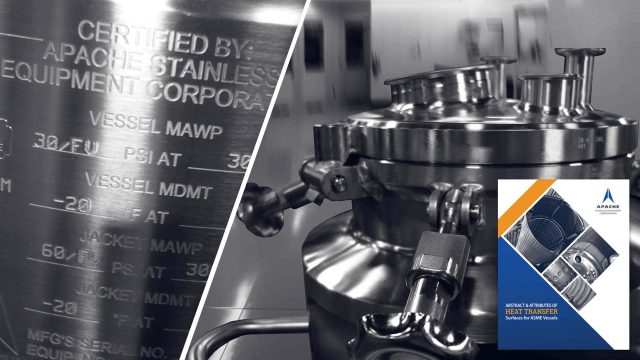
Thermal heat exchange surfaces control the temperature in the vessel and the quality of the contents. Jacketed vessels are used in many industries and can be used to remove the elevated heat of reaction (heat reactor vessel) or reduce the viscosity of high viscous fluids. In an updated eBook, the Apache team has fine-tuned a guide (link) to explain applications, pressure criteria, and ASME requirements for Conventional Jackets, Dimple Jackets and Half Pipe Coil Jackets.
Conventional Jackets
Conventional jackets are an open jacket with an annular space containing the heat transfer media on the exterior surface of the tank. In some instances, internally welded baffles within the conventional jacket control the flow of the heating or cooling agent. In Apache’s experience, water, oil, or heat transfer fluid is typically used as heat transfer agents for conventional jackets.
Variable coverage areas and pressures are available in conventional jacket designs.
Dimple Jackets
Dimple jackets utilize a thin gauge stainless steel layer that is plug welded to the vessel shell in a regular pattern. The punched and spot-welded areas are called dimples, which create turbulence of the heating or cooling fluid flowing through the jacket. The dimple jacket design allows for thinner vessel shell walls than a conventional jacket design due to the strength of the dimple pattern design.
Dimple jackets are manufactured in several different pressures and patterns. Apache fabricates with 12 ga. and 14 ga. material. Each pattern is validated, and proof tested per ASME regulations. Apache has proofed and certified designs up to 1 ¾” at 200psig at 300o F but can go to higher temperatures depending on the application.
Half Pipe Coil Jackets
The half-pipe jacketed vessel has a split pipe (split evenly or rolled formed sheet) wound around the vessel and welded into place. This design provides optimal strength and can be rated up to 500psig. Half-pipe jackets are recommended for high-temperature and liquid heat-transfer applications.
Material used for half-pipe jackets are commonly 304, 304L or 316 and can be welded to a range of alloys. Sound welding practices allow the half pipe to be welded to high alloys.
Compliance engineering for industries requiring ASME code certification and fabrication is what we do. Dedicated project engineers provide control over calculations, component selection, compliant designs, approvals, testing and certification. Apache has experience and reputation with inspectors, agencies, and governing officials for successful and efficient compliance vessel projects.
Download the eBook “Heat Transfer Surfaces for ASME Vessels” (link) for ASME and application information about heat transfer methods.
